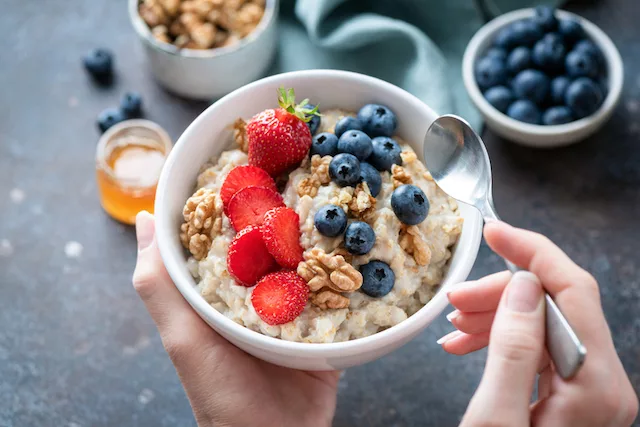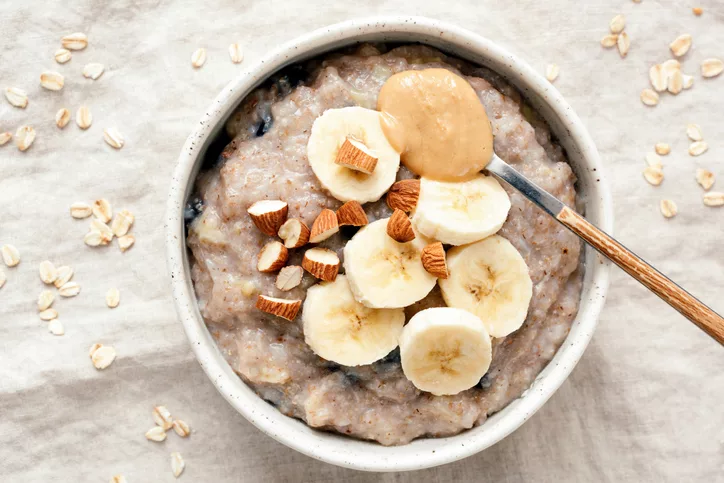Thanks to TikTok buzz, oatmeal has landed in hot water. Puns aside, online rumors have surfaced accusing oatmeal of being one of the worst foods that one could eat – despite its long-standing reputation as a heart-healthy breakfast option. As a result, there are many contradictory opinions as to whether or not oats are good for you .
This article will break down what the science says to answer, is oatmeal good for you? Not to mention, a selection of dietitian-approved oat-based recipes.

Is Oatmeal Good For You?
The short answer is yes, oatmeal is good for you. But before diving into why, let’s address some of the misconceptions that have been giving oatmeal a bad rep.
Oatmeal is high in a compound called phytic acid. The main role of phytic acid is to store phosphate inside of oats and other foods like beans, nuts, and seeds.
Phytic acid is sometimes called an anti-nutrient because it binds to minerals, making them less available for absorption. For this reason, people speculate that eating oatmeal can cause low levels of minerals like copper, iron, zinc, and calcium.
Fortunately, your morning oatmeal is very unlikely to cause a nutrient deficiency.
Although phytic acid in oats is naturally occuring, its levels are typically low by the time we are consuming them. Most of us don’t eat raw oats, and almost all oatmeal recipes call for oats to be prepared in a way that lowers its anti-nutrient content. For example, cooking or soaking oats decreases phytic acid and is common practice for nearly all oat-based recipes.
It’s worth mentioning that oatmeal offers a highly impressive nutritious profile which can actually boost your intake of minerals and B vitamins. Researchers also cite that eating whole grains, like oatmeal, are associated with better health outcomes.
The Nutritional Benefits of Oats
As mentioned, oats are an excellent way to get a boost of vitamins and minerals. So naturally, they bring a ton of health benefits to the table. Seriously, oats can benefit your heart and weight, too.
Here are the top reasons for why oatmeal is good for you:
1. Heart-Health
Oats are an excellent part of a heart-healthy diet. In fact, the FDA has declared that eating oatmeal or oat bran can can lower serum cholesterol. This is impressive because the FDA does not give out health claims easily. In order for a food to earn a health claim, they must meet a significant agreement standard which means consensus among qualified health experts and scientific evidence.
A soluble fiber called beta-glucan is responsible for its heart health benefits. When consumed, beta-glucan draws in water and turns into a gel-like substance. As it travels through the digestive tract, it’s able to bind to cholesterol so that it can be eliminated via bowel movements.
This action helps prevent “bad” LDL cholesterol from being absorbed into the blood vessels where it can potentially accumulate as plaques in the arteries. Supporting clear arteries is one of the best ways to allow proper blood flow to the heart.
2. regular poops
In addition to soluble fiber, oats also deliver insoluble fibers like lignin and cellulose. Unlike the soluble beta-glucan fiber that attracts water and turns into a gel, insoluble fibers remain undigested as they move through the digestion tract.
Along the way, insoluble fiber will add bulk to your poop for easier elimination from the body. For this reason, they are great at minimizing constipation and promoting regularity.
3. Blood sugar & weight management
Oats can play a positive role in supporting healthy blood sugar levels. The insoluble fibers present in oats are known as complex carbohydrates. This group of carbohydrates are digested very slowly. This means steady blood sugar levels without spikes and dips.
They can also have an effect on your weight. Blood sugar fluctuations can increase cravings, making it difficult to manage a healthy caloric intake. On the flip side, healthy blood sugar levels can help you feel in better control of your appetite.
Moreover, there are multiple studies citing the positive effects that diets that include oats can have on anthropometric measures such as weight, waist-to-hip ratio, and BMI.
How To Eat More Oats
Oats are one of the most versatile foods and are incredibly easy to prepare. Although we typically see oats in breakfast meals, they can seamlessly work as a snack, dessert, and even as part of a dinner dish.
Here are 4 dietitian-approved oat-based recipes to try out:
Protein Oatmeal
Oatmeal is a classic breakfast option. By making your morning oats with a protein twist, you can promote longer feelings of fullness and better blood sugar balance.
What You’ll Need:
- 1/2 cup old-fashioned oats (or plain instant oats)
- 1 cup milk of choice
- 1 ripe banana, mashed
- 1 tablespoon nut butter of choice
- 1 scoop of HUM’s Core Strength digestion-friendly vanilla protein powder
- Optional toppings: drizzle of honey or maple syrup, sliced banana, chia seeds, mini chocolate chips, chopped nuts, berries, etc.

How To Prepare:
1. In a saucepan, combine the oats and milk. Heat over medium heat, stirring occasionally, until the mixture starts to simmer.
2. Reduce the heat to low and continue to cook the oats, stirring occasionally, for about 5-7 minutes, or until the oats are creamy and cooked to your desired consistency.
3. Mix in Core Strength during the last minute of cooking.
4. Remove the saucepan from the heat and mix in the mashed banana and nut butter.
5. Transfer oatmeal into a bowl and add toppings of choice.
Feel free to personalize this recipe by adjusting the sweetness with toppings. This oatmeal is not only tasty, but is also a filling breakfast option packed with fiber, plant-proteins, and healthy fats.
No-Bake Mint Chocolate Chip Energy Balls
Easily add oats to your diet by trying this no-bake mint chocolate chip energy ball recipe. Perfect for a midday pick-me-up!
What You’ll Need:
- 1 cup old-fashioned oats
- 1 scoop HUM’s Raw Beauty Mint Chocolate Chip superfood powder
- 1/2 cup peanut butter
- 1/3 cup honey or maple syrup
- 1/2 cup chia seeds
- ½ cup cacao nibs or chocolate chips (optional for texture & added flavor)
- 1 teaspoon vanilla extract
How To Prepare:
1. Combine all ingredients in a large bowl and stir well.
2. Refrigerate mixture for about 15-30 minutes. Tip: the longer it’s refrigerated, the easier it’ll be to handle
3. Once chilled, take small portions and roll them into bite-sized balls using your hands. If the mixture is too sticky, you can lightly wet your hands with water.
5. Place the energy bites on a parchment-lined tray or plate. Let the energy bites sit in the refrigerator for another 15-30 minutes before enjoying.
Tip: you can save them for later by storing them in an airtight container in the fridge.
These no-bake oat energy bites are an easy way to satisfy a sweet tooth all while boosting your energy. They’re great for a quick snack on the go and are easily customizable.
Oat-Crusted Air Fry Chicken
Here’s a recipe for oat-crusted chicken that makes for a savory lunch or dinner option.
What You’ll Need:
- 2 boneless, skinless chicken breasts
- 1/2 cup old-fashioned oats
- 1/4 cup grated parmesan cheese
- 1/2 teaspoon paprika
- 1/2 teaspoon dried thyme or other herbs of your choice
- Salt and pepper to taste
- 1 egg, beaten
- Cooking spray or olive oil
How To Prepare:
1. Preheat the air fryer to 390 F.
2. In a food processor or blender, pulse the oats until they’re finely ground, but not turned into flour.
3. In a shallow dish, combine the ground oats, cheese, paprika, dried thyme, salt, and pepper. Mix well to combine the dry ingredients.
4. In a separate shallow dish, beat the egg..
5. Dip each chicken breast into the beaten egg, allowing any excess to drip off.
6. Coat the chicken breasts with the oat mixture, pressing the mixture onto the chicken.
7. Place the coated chicken breasts in a single layer inside the air fryer.
8. Cook for 15 minutes, turning after 10 minutes.
10. Remove from the air fryer. Tip: let the chicken rest for a few minutes before serving.
This oat-crusted chicken works well with your favorite side dishes, such as vegetables, salad, or roasted potatoes.
Banana Oatmeal Cookies
Banana oatmeal cookies are a simple and healthy sweet treat.
What You’ll Need:
- 2 ripe bananas, mashed
- 1 cup old-fashioned oats
- 1/2 cup peanut butter (or any nut/seed butter)
- 1/4 cup maple syrup
- 1/2 teaspoon vanilla extract
- 1/2 teaspoon ground cinnamon
- ¼ cup mini chocolate chips (optional)
- ¼ cup chopped walnuts (optional)
How To Prepare:
1. Preheat your oven to 350°F (175°C).
2. In a mixing bowl, combine the mashed bananas, peanut butter, honey or maple syrup, and vanilla extract. Stir until well combined.
3. Work in the oats and cinnamon into the bowl. Stir until all the ingredients are well combined.
4. If you’re adding mini chocolate chips or walnuts, gently fold them into the cookie dough.
5. Using a spoon or your hands, drop spoonfuls of the cookie dough onto a baking sheet lined with parchment paper. Tip: use the back of a spoon or your fingers to lightly flatten each cookie.
6. Bake for 12-15 minutes, or until the cookies are golden around the edges.
7. Remove from the oven. Allow the cookies to rest for a few minutes before transferring them to a wire rack to cool completely.
Enjoy banana oatmeal cookies without the guilt. They are a healthier alternative to traditional cookies, as they’re sweetened with bananas and maple syrup.
If banana oatmeal cookies aren’t your thing, check out this oat-based snickerdoodle bake instead.
Conclusion
The bottom line is that oatmeal is good for you. Oats deliver vitamins, minerals, and dietary fiber. They are a great addition to a balanced diet that prioritizes heart health, digestion, and blood sugar balance. Plus, they are incredibly versatile and easy to incorporate into recipes at breakfast, lunch or dinner.

